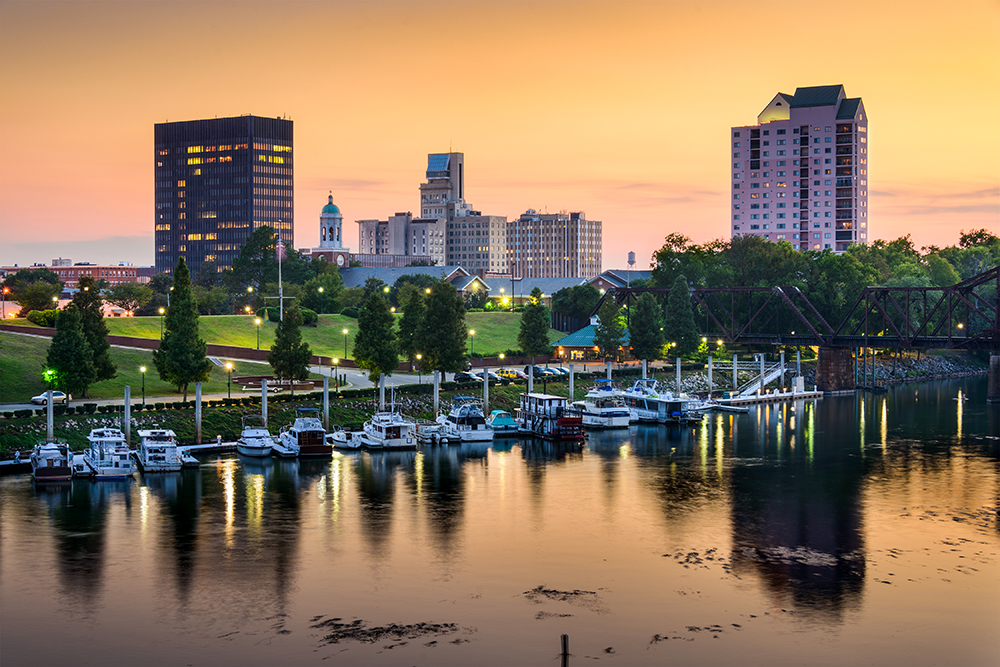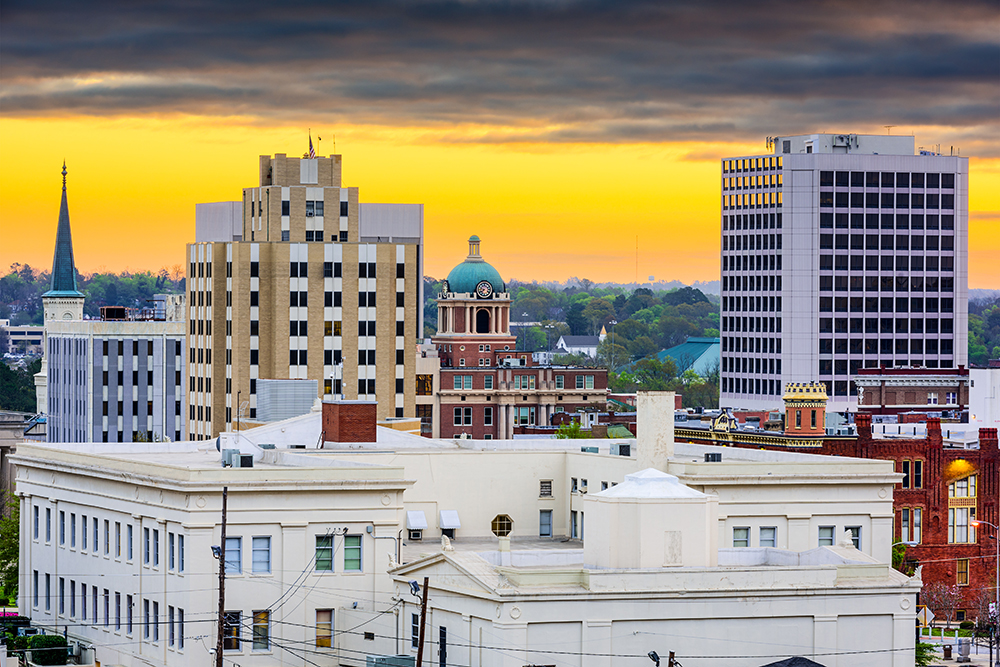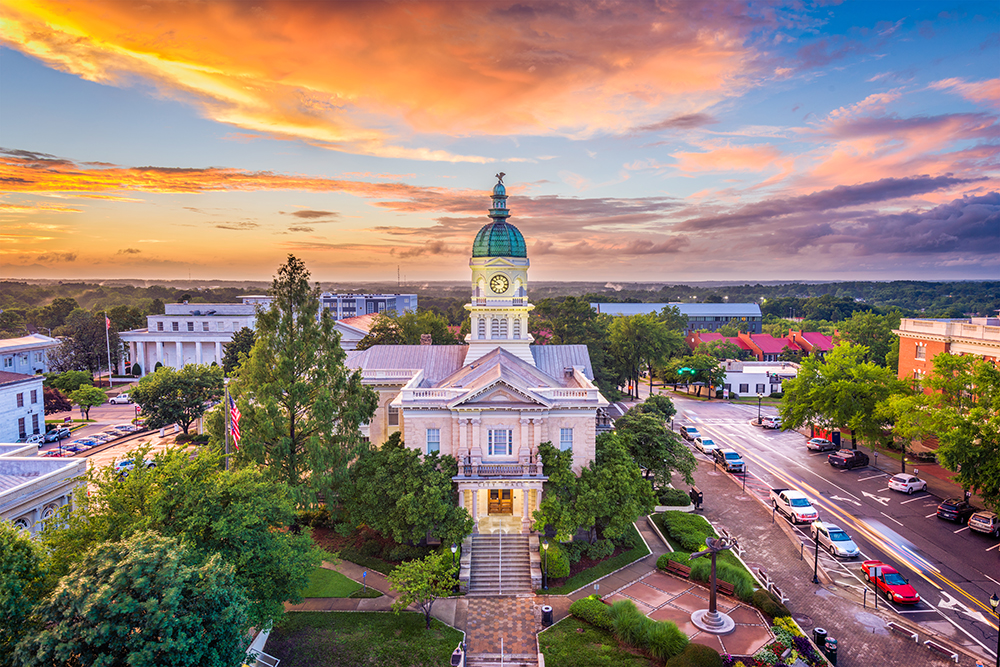
The following table shows current 30-year El Monte mortgage rates. You can use the menus to select other loan durations, alter the loan amount. or change your location.

The vast majority of the state's growth is taking place in the northwest corner of the state, in the Atlanta metropolitan area. Other areas of the state, however, are working diligently to attract businesses with the promise of hardworking labor (Georgia is a right-to-work state), beautiful climate and low taxes. With ninety miles of Atlantic coastline, mountains in the state's northwest corner, a temperate climate, historic sites dating back to pre-colonial days, and cultural, educational and recreational opportunities sprinkled generously throughout the state, Georgia's a wonderful place to live and work, a fact recognized already by millions of Americans.
Residents of the state of Georgia enjoy low property tax rates plus below-average home prices. Median incomes do an adequate job of paying for real estate, and there is plenty of housing assistance for families who need it.
While there are colleges and universities located in all the state's metropolitan areas, the Atlanta area is also notable for the number of colleges and universities it encompasses – currently around 45. These are located in downtown Atlanta as well as throughout the metropolitan region, and attract businesses oriented toward the student population.

The state of Georgia has a population of over 10 million residents, and most of these people live in the state's ten largest cities. Georgia's population is growing at a pace that makes it one of the fastest-growing regions in the country. This has resulted in a recent uptick of home construction.
The median home price in the Atlanta metro area is around $125,000, according to data released by the National Association of Realtors. This is just a rough idea of what a home can cost in the region. Significant variation exists among property types and locations. For example, short sales, foreclosures, and other distressed properties will have below-average prices. Residents of Forsyth County pay on average of $195,000, while Gilmer County has an average of just $87,000.
These numbers are encouraging for the Peach State when compared to U.S. averages that have been computed by the National Association of Realtors. The group estimates the median home in the country costs roughly $231,000. So Georgia offers homes that are tens of thousands of dollars cheaper than comparable homes elsewhere.
On a per-square-foot basis, the median Georgian home runs about $85. This is significantly below the national average, which hovers around $140.
Despite Georgia's low prices, property values there are growing. Recent market data calculate the growth at about 7%, although this rate is expected to decrease to around 4-5% in the near future.
This home price appreciation, however, slowed significantly and even reversed when the Great Recession of 2007 showed up. The mortgage crisis created a large number of unoccupied housing units in the Atlanta metro area. These houses had either been foreclosed on or were in the foreclosure process.
While real estate prices suffered nationwide due to the recession, in Georgia the impact was felt somewhat more severely because of the ongoing housing boom in the Atlanta area, driven by the influx of new residents and the expectation of millions more over the next two decades. Expected sales of newly-built homes failed to materialize, however, and some construction projects were suspended. Housing prices are stabiled, though, with minor gains being recorded in some areas. Median housing prices in the Atlanta area were depressed from the highs they recorded in the middle of the decade, with the median home sale price at just under $125,000 at the end of 2009, according to the National Association of Realtors. Actual sales vary widely from this figure, though, since many of the sales recorded were for distressed properties (short sales, sales to avoid foreclosure, etc.). This is an ideal situation, though, for investors who are seeking to spruce up and rent distressed housing. In the wider metropolitan area, average prices run from a low of $86,200 in Gilmer County to a high of $194,250 in Forsyth County. These prices compare very favorably with the Realtors’ report of average prices nationwide (just under $175,000) and in the South (low 150's).
The opportunities for growth, especially in the Atlanta area, were seen in the 1980's and 1990's, spurring an unprecedented surge in residential construction. When the bubble burst in 2008, there was an enormous inventory of unoccupied housing in the Atlanta area, much of it foreclosed or in the foreclosure process. While a boon for investors looking for bargains in an area where there's still growth and a demand for housing, it posed problems for homeowners trying to sell their houses, and investors seeking to “flip” distressed properties. That said, as home ownership rates declined over the past 15 years from 71.8% in 2002 to 62.3% in 2016, population continued to grow. The cheap home inventory led to fantastic returns for landlords.
The S&P/Case-Shiller Atlanta Home Price Index shows a very steep drop for residential properties in that city, beginning in August of 2007. The downward trend did not bottom out until March of 2012. When the dust settled, it was a 40% decline, meaning that homes in the Atlanta area had lost almost half of their value in less than five years. The index reached its pre-Recession level in the spring of 2017, and has been increasing ever since.
During the housing debacle, foreclosures became a problem in the Peach State, according to Georgia Watch, a non-profit 501(c)(3) group that studies important issues in the state. There were more than 48,000 foreclosures in just a year and a half, from the beginning of 2008 until the midpoint of 2009. Past due mortgages during this time period numbered almost a quarter of a million. There were half a million mortgages either underwater or nearly underwater, which of course was largely due to the decline in home values, but rising unemployment also contributed. These difficulties placed Georgia in the top ten for worst foreclosure states.
According to Georgia Watch's research, Fulton, Gwinnett and DeKalb Counties were the hardest hit in the state. They generated over 20,000 combined foreclosures every month at the height of the crisis.
Despite Georgia's struggles with foreclosures during the real estate mess, the state has seen a recovery. Currently, the Peach State's foreclosure rate is about 1 home for every 3,373, according to RealtyTrac, an organization that follows home delinquencies. The national average is 1 out of 2,079, which puts Georgia in a much better position on this issue now.
Through the first 3 quarters of 2020 real estate held up far better than it did during the 2008 housing recession. Central banks and politicians reacted faster and much more aggressively to the COVID-19 crisis than they did to the 2008 recession. Many novel and unconventional policies which began in response to the prior recession were used much more aggressively in this recession. For instance, here are some of the policies which were enacted:
On November 24, 2020 the Federal Housing Finance Agency (FHFA) raised conforming loan limits by 7.42%, reflecting strong annual growth in the nationwide FHFA House Price Index (HPI). 2022 and 2023 saw limit increases of 18.05% and 12.21%, the fastest 2-year growth rates since 1986 & 1987, and inline with the 15.95% growth in 2006. In 2024 and 2025 the limits were increased at more historically normal levels of 5.56% and 5.21%.
| GA Rank | US Rank | Geography | 2016 Pop | 2010 Pop | Change | % △ |
|---|---|---|---|---|---|---|
| 1 | 9 | Atlanta-Sandy Springs-Roswell | 5,789,700 | 5,286,728 | 502,972 | 9.51% |
2 |
93 | Augusta-Richmond County, GA-SC Metro Area | 594,919 | 564,873 | 30,046 | 5.32% |
| 3 | 100 | Chattanooga, TN-GA Metro Area | 551,632 | 528,143 | 23,489 | 4.45% |
| 4 | 137 | Savannah | 384,024 | 347,611 | 36,413 | 10.48% |
| 5 | 161 | Columbus, GA-AL Metro Area | 308,755 | 294,865 | 13,890 | 4.71% |
| 6 | 196 | Macon-Bibb County | 229,182 | 232,293 | -3,111 | -1.34% |
| 7 | 217 | Athens-Clarke County | 205,290 | 192,541 | 12,749 | 6.62% |
| 8 | 223 | Gainesville | 196,637 | 179,684 | 16,953 | 9.43% |
| 9 | 227 | Warner Robins | 190,028 | 179,605 | 10,423 | 5.80% |
| 10 | 272 | Albany | 152,219 | 157,308 | -5,089 | -3.24% |
| 11 | 291 | Valdosta | 144,676 | 139,588 | 5,088 | 3.65% |
| 12 | 292 | Dalton | 143,904 | 142,227 | 1,677 | 1.18% |
| 13 | 343 | Brunswick | 116,784 | 112,370 | 4,414 | 3.93% |
| 14 | 399 | Rome | 96,560 | 96,317 | 243 | 0.25% |
| 15 | 443 | Hinesville | 81,007 | 77,917 | 3,090 | 3.97% |
| 16 | 466 | Statesboro | 74,722 | 70,217 | 4,505 | 6.42% |
| 17 | 480 | LaGrange | 70,005 | 67,044 | 2,961 | 4.42% |
| 18 | 502 | Jefferson | 64,615 | 60,485 | 4,130 | 6.83% |
| 19 | 544 | Dublin | 57,021 | 58,414 | -1,393 | -2.38% |
| 20 | 545 | Calhoun | 56,904 | 55,186 | 1,718 | 3.11% |
| 21 | 556 | Waycross | 54,909 | 55,070 | -161 | -0.29% |
| 22 | 567 | Milledgeville | 53,784 | 55,149 | -1,365 | -2.48% |
| 23 | 572 | St. Marys | 53,008 | 50,513 | 2,495 | 4.94% |
| 24 | 630 | Moultrie | 45,708 | 45,498 | 210 | 0.46% |
| 25 | 638 | Thomasville | 45,248 | 44,720 | 528 | 1.18% |
| 26 | 650 | Cornelia | 44,246 | 43,041 | 1,205 | 2.80% |
| 27 | 663 | Douglas | 43,012 | 42,356 | 656 | 1.55% |
| 28 | 675 | Cedartown | 41,776 | 41,475 | 301 | 0.73% |
| 29 | 683 | Tifton | 40,828 | 40,118 | 710 | 1.77% |
| 30 | 750 | Vidalia | 36,256 | 36,346 | -90 | -0.25% |
| 31 | 760 | Americus | 35,487 | 37,829 | -2,342 | -6.19% |
| 32 | 817 | Jesup | 30,104 | 30,099 | 5 | 0.02% |
| 33 | 830 | Eufaula, AL-GA Micro Area | 28,300 | 29,970 | -1,670 | -5.57% |
| 34 | 845 | Bainbridge | 26,822 | 27,842 | -1,020 | -3.66% |
| 35 | 851 | Thomaston | 26,335 | 27,153 | -818 | -3.01% |
| 36 | 858 | Toccoa | 25,751 | 26,175 | -424 | -1.62% |
| 37 | 867 | Summerville | 24,824 | 26,015 | -1,191 | -4.58% |
| 38 | 879 | Cordele | 22,721 | 23,439 | -718 | -3.06% |
| 39 | 920 | Fitzgerald | 17,243 | 17,634 | -391 | -2.22% |

The largest city in the state of Georgia is Atlanta, which is also the biggest metro area. The population of Atlanta is 421,000, while the metro area is roughly 5.8 million. The region's economy is driven by several industries. The international airport, which lies just outside of Atlanta city limits, is one of the world's busiest. Delta Air Lines is a major employer. There is a large media presence in the city with both CNN and TBS having headquarters there. Other companies located in Atlanta include The Coca-Cola Company, Home Depot, and Chick-fil-A.
Atlanta has a vibrant performing arts tradition with several professional associations, including The Atlanta Opera and Atlanta Ballet. There are also many museums in the area, including the Museum of Contemporary Art of Georgia. The world's largest indoor aquarium, the Georgia Aquarium, is in the city.
Atlanta has professional baseball, basketball & football teams in the Braves, Hawks and Falcons.
The median home price in Atlanta is $125,000. The U.S. Census Bureau reports a household median income of $49,000. Thus, we see a home price-to-income ratio of 2.55, which is outstanding.

The second-largest city in Georgia is Augusta, internationally known for hosting The Masters golf tournament each spring. The city has a downtown area that is on the National Register of Historic Places for its pre-Civil War buildings. Top employers in the area include Fort Gordon, a U.S. Army base, and Augusta University.
August has a median income of $39,000 and a median home value of $130,000. Thus, we see a price-to-income metric of 3.33, which is pretty good.

The third-largest city in the state of Georgia is Columbus. With a population of over 200,000, the city is home to Fort Benning, one of the largest U.S. Army bases in the world. The military installation is by far the largest employer in the area. Columbus is also home to many museums, including the National Civil War Naval Museum, and several arenas for performing arts.
The U.S. Census Bureau reports a median household income of $44,000 and a household income of $136,000 for Columbus. Putting these together, we see a metric of 3.09.

Next in line is Macon, home to 160,000 residents. The city is known for its many festivals, including International Cherry Blossom Festival, held every March. There are also historic sites and museums, including one for the Allman Brothers Band, which was located in Macon in the early 1970's.
Macon has a median household income of $30,000. Combined with a median home value of $135,000, we get a price-to-income number of 4.5.

Residents of Savannah have access to the Atlantic coast, as the city is the only one in our survey to be located there. With a history in both the Civil War and the War of Independence, Savannah has large swaths of land included on the list of National Historic Landmarks. The Savannah Music Festival is held in the city every year.
Major drives of the economy in Savannah include the city's seaport, which is sees a large amount of container traffic. International Paper has a large presence, and Gulfstream Aerospace also provides jobs.
Savannah has a median home price of $190,000, and a household income of $38,000. Hence, we get a price-to-income ratio of 5.0.
 Athens is located further north, and is home to nearly 120,000. The city is home to the Georgia Museum of Art, the state's official art museum. It also has the State Botanical Garden of Georgia and several Civil War sites. More modern attractions include restaurants, bars, and music venues.
Athens is located further north, and is home to nearly 120,000. The city is home to the Georgia Museum of Art, the state's official art museum. It also has the State Botanical Garden of Georgia and several Civil War sites. More modern attractions include restaurants, bars, and music venues.
The local economy has large pharmaceutical and biotechnology sectors. The University of Georgia is a major employer. Hill Street Press is headquartered in the city.
Athens has a median home price of $165,000 and a median income of $34,000. These numbers produce a price-to-income ratio of 4.85.
The fastest growing region of the Peach State is Forsyth County, located roughly 20 miles northeast of Atlanta. The population is roughly 222,000. The county seat is Cumming, with less than 7,000 people. The commute time from the southwestern portion of the county to downtown Atlanta is about 45 minutes.
The median value of an owner-occupied house is roughly $270,000, according to the Census Bureau. With a median household income of $90,000, we find a metric of exactly 3.0, slightly higher than Atlanta's.
Lower home prices can be found in Berrien County, which is located in the southern part of the state. It's closer to Jacksonville, Florida than Atlanta. The population of Berrien County is approximately 20,000. Jobs are created by administrative, management, education, and construction industries.
The median home value in the county is $86,000, a tremendous bargain. The median income, however, is a very low $33,000, less than half that of Forsyth County's. These numbers produce a metric of 2.61, very close to Atlanta's ratio.
As of July 1, 2016 the state of Georgia has an estimated population of 10,310,371 across 57,513.59 mi² yielding a population density of 179.27 people per mi² across the state.
The following table highlights the July 1, 2016 populations of cities, towns & Census Designated Places (CDP) with over 5,000 residents based on United States Census Bureau estimates. For Census Designated Places (CDP) where there was no population estimate available for 2016, the 2011-2015 American Community Survey 5-Year Estimates data was used.
All table columns are sortable. Click on the column headers to sort by that column. Click again to sort low to high. Cities with higher levels of population growth typically see the increased demand drive faster real estate price appreciation.
| Rank | Geography | County | 2016 Pop | 2010 Pop | Change | % △ | Land mi² | Pop Den mi² |
|---|---|---|---|---|---|---|---|---|
| 1 | Atlanta | Fulton & DeKalb | 472,522 | 420,003 | 52,519 | 12.50% | 133.15 | 3,548.79 |
| 2 | Columbus | Muscogee | 197,485 | 189,885 | 7,600 | 4.00% | 216.39 | 912.63 |
| 3 | Augusta | Richmond | 197,081 | 198,844 | -1,763 | -0.89% | 324.33 | 607.66 |
| 4 | Macon | Bibb & Jones | 152,555 | 91,351 | 61,204 | 67.00% | 249.96 | 610.32 |
| 5 | Savannah | Chatham | 146,763 | 136,286 | 10,477 | 7.69% | 103.15 | 1,422.81 |
| 6 | Athens | Clarke | 123,371 | 115,452 | 7,919 | 6.86% | 117.8 | 1,047.29 |
| 7 | Sandy Springs | Fulton | 105,703 | 93,853 | 11,850 | 12.63% | 37.64 | 2,808.26 |
| 8 | Roswell | Fulton | 94,598 | 88,346 | 6,252 | 7.08% | 40.72 | 2,323.13 |
| 9 | Johns Creek | Fulton | 83,873 | 76,728 | 7,145 | 9.31% | 30.73 | 2,729.35 |
| 10 | Warner Robins | Houston & Peach | 74,388 | 66,588 | 7,800 | 11.71% | 35.07 | 2,121.13 |
| 11 | Albany | Dougherty | 73,801 | 77,434 | -3,633 | -4.69% | 55.13 | 1,338.67 |
| 12 | Alpharetta | Fulton | 65,338 | 57,551 | 7,787 | 13.53% | 26.91 | 2,428.02 |
| 13 | Marietta | Cobb | 60,941 | 56,579 | 4,362 | 7.71% | 23.08 | 2,640.42 |
| 14 | Smyrna | Cobb | 56,664 | 51,271 | 5,393 | 10.52% | 15.35 | 3,691.47 |
| 15 | Valdosta | Lowndes | 56,474 | 54,518 | 1,956 | 3.59% | 35.83 | 1,576.17 |
| 16 | Brookhaven | DeKalb | 52,444 | 40,456 | 11,988 | 29.63% | 12 | 4,370.33 |
| 17 | Dunwoody | DeKalb | 48,884 | 46,267 | 2,617 | 5.66% | 12.94 | 3,777.74 |
| 18 | Peachtree Corners | Gwinnett | 42,773 | 34,364 | 8,409 | 24.47% | 16 | 2,673.31 |
| 19 | Gainesville | Hall | 40,000 | 33,804 | 6,196 | 18.33% | 31.93 | 1,252.74 |
| Mableton CDP | Cobb | 39,589 | 37,115 | 2,474 | 6.67% | 20.57 | 1,924.60 | |
| 20 | Milton | Fulton | 38,411 | 32,661 | 5,750 | 17.61% | 38.52 | 997.17 |
| 21 | Newnan | Coweta | 37,912 | 33,039 | 4,873 | 14.75% | 18.32 | 2,069.43 |
| Martinez CDP | Columbia | 36,895 | 35,795 | 1,100 | 3.07% | 14.51 | 2,542.73 | |
| 22 | Rome | Floyd | 36,407 | 36,303 | 104 | 0.29% | 30.91 | 1,177.84 |
| 23 | East Point | Fulton | 35,471 | 33,712 | 1,759 | 5.22% | 14.67 | 2,417.93 |
| 24 | Tucker | DeKalb | 35,322 | 1,827 | 33,495 | 1833.33% | 19.97 | 1,768.75 |
| 25 | Peachtree City | Fayette | 35,186 | 34,364 | 822 | 2.39% | 24.54 | 1,433.82 |
| 26 | Dalton | Whitfield | 34,077 | 33,128 | 949 | 2.86% | 20.54 | 1,659.06 |
| Evans CDP | Columbia | 33,730 | 29,011 | 4,719 | 16.27% | 25.27 | 1,334.78 | |
| 27 | Kennesaw | Cobb | 33,627 | 29,783 | 3,844 | 12.91% | 9.44 | 3,562.18 |
| 28 | Hinesville | Liberty | 33,577 | 33,437 | 140 | 0.42% | 20.37 | 1,648.36 |
| 29 | Douglasville | Douglas | 33,252 | 30,961 | 2,291 | 7.40% | 22.46 | 1,480.50 |
| Redan CDP | DeKalb | 32,614 | 33,015 | -401 | -1.21% | 9.61 | 3,393.76 | |
| 30 | Statesboro | Bulloch | 31,419 | 28,422 | 2,997 | 10.54% | 13.5 | 2,327.33 |
| 31 | Woodstock | Cherokee | 30,929 | 23,896 | 7,033 | 29.43% | 11.16 | 2,771.42 |
| 32 | Lawrenceville | Gwinnett | 30,782 | 28,546 | 2,236 | 7.83% | 13.39 | 2,298.88 |
| 33 | LaGrange | Troup | 30,771 | 29,588 | 1,183 | 4.00% | 39.51 | 778.82 |
| 34 | Duluth | Gwinnett | 29,331 | 26,600 | 2,731 | 10.27% | 9.99 | 2,936.04 |
| 35 | Stockbridge | Henry | 28,677 | 25,636 | 3,041 | 11.86% | 13.31 | 2,154.55 |
| 36 | Chamblee | DeKalb | 28,306 | 9,892 | 18,414 | 186.15% | 3.18 | 8,901.26 |
| Tucker CDP | DeKalb | 27,761 | 27,581 | 180 | 0.65% | 11.98 | 2,317.28 | |
| 37 | Carrollton | Carroll | 26,562 | 24,388 | 2,174 | 8.91% | 22.29 | 1,191.66 |
| 38 | Canton | Cherokee | 26,340 | 22,958 | 3,382 | 14.73% | 18.59 | 1,416.89 |
| 39 | McDonough | Henry | 23,964 | 22,084 | 1,880 | 8.51% | 12.71 | 1,885.44 |
| 40 | Pooler | Chatham | 23,744 | 19,140 | 4,604 | 24.05% | 29.39 | 807.89 |
| 41 | Griffin | Spalding | 22,928 | 23,643 | -715 | -3.02% | 13.92 | 1,647.13 |
| Candler-McAfee CDP | DeKalb | 22,835 | 23,025 | -190 | -0.83% | 7.01 | 3,257.49 | |
| 42 | Decatur | DeKalb | 22,813 | 19,335 | 3,478 | 17.99% | 4.27 | 5,342.62 |
| 43 | Acworth | Cobb | 22,418 | 20,425 | 1,993 | 9.76% | 8.24 | 2,720.63 |
| 44 | Sugar Hill | Gwinnett | 22,197 | 18,522 | 3,675 | 19.84% | 10.6 | 2,094.06 |
| 45 | Union City | Fulton | 20,919 | 19,456 | 1,463 | 7.52% | 19.11 | 1,094.66 |
| 46 | Cartersville | Bartow | 20,753 | 19,731 | 1,022 | 5.18% | 29.15 | 711.94 |
| 47 | Snellville | Gwinnett | 19,738 | 18,242 | 1,496 | 8.20% | 10.45 | 1,888.80 |
| 48 | Forest Park | Clayton | 19,731 | 18,468 | 1,263 | 6.84% | 9.28 | 2,126.19 |
| 49 | Suwanee | Gwinnett | 19,421 | 15,355 | 4,066 | 26.48% | 10.88 | 1,785.02 |
| 50 | Milledgeville | Baldwin | 18,933 | 17,715 | 1,218 | 6.88% | 20.41 | 927.63 |
| 51 | Thomasville | Thomas | 18,826 | 18,413 | 413 | 2.24% | 14.95 | 1,259.26 |
| North Druid Hills CDP | DeKalb | 18,385 | 18,947 | -562 | -2.97% | 5.04 | 3,647.82 | |
| 52 | St. Marys | Camden | 18,088 | 17,121 | 967 | 5.65% | 22.51 | 803.55 |
| 53 | Fayetteville | Fayette | 17,519 | 15,945 | 1,574 | 9.87% | 10.89 | 1,608.72 |
| Lithia Springs CDP | Douglas | 17,246 | 15,491 | 1,755 | 11.33% | 13.6 | 1,268.09 | |
| North Decatur CDP | DeKalb | 17,040 | 16,698 | 342 | 2.05% | 4.98 | 3,421.69 | |
| 54 | Tifton | Tift | 16,836 | 16,350 | 486 | 2.97% | 12.49 | 1,347.96 |
| 55 | Norcross | Gwinnett | 16,787 | 9,116 | 7,671 | 84.15% | 4.64 | 3,617.89 |
| 56 | Kingsland | Camden | 16,720 | 15,946 | 774 | 4.85% | 42.72 | 391.39 |
| 57 | Calhoun | Gordon | 16,445 | 15,650 | 795 | 5.08% | 14.93 | 1,101.47 |
| 58 | Brunswick | Glynn | 16,346 | 15,383 | 963 | 6.26% | 17.07 | 957.59 |
| 59 | Riverdale | Clayton | 16,258 | 15,134 | 1,124 | 7.43% | 4.53 | 3,588.96 |
| Belvedere Park CDP | DeKalb | 16,214 | 15,152 | 1,062 | 7.01% | 4.92 | 3,295.53 | |
| 60 | Perry | Houston & Peach | 16,200 | 13,839 | 2,361 | 17.06% | 26.18 | 618.79 |
| 61 | Dublin | Laurens | 16,104 | 16,201 | -97 | -0.60% | 15.49 | 1,039.64 |
| 62 | Conyers | Rockdale | 15,919 | 15,195 | 724 | 4.76% | 11.66 | 1,365.27 |
| 63 | Americus | Sumter | 15,854 | 17,041 | -1,187 | -6.97% | 11.24 | 1,410.50 |
| 64 | Winder | Barrow | 15,777 | 14,099 | 1,678 | 11.90% | 12.41 | 1,271.31 |
| 65 | Villa Rica | Carroll & Douglas | 15,201 | 13,956 | 1,245 | 8.92% | 14.24 | 1,067.49 |
| 66 | College Park | Fulton & Clayton | 15,035 | 13,942 | 1,093 | 7.84% | 10.07 | 1,493.05 |
| 67 | Powder Springs | Cobb | 14,956 | 13,940 | 1,016 | 7.29% | 7.17 | 2,085.91 |
| Wilmington Island CDP | Chatham | 14,781 | 15,138 | -357 | -2.36% | 8.2 | 1,802.56 | |
| 68 | Moultrie | Colquitt | 14,361 | 14,268 | 93 | 0.65% | 16.34 | 878.89 |
| 69 | Buford | Gwinnett & Hall | 14,356 | 12,225 | 2,131 | 17.43% | 17.01 | 843.97 |
| 70 | Fairburn | Fulton | 14,182 | 12,950 | 1,232 | 9.51% | 16.85 | 841.66 |
| 71 | Waycross | Ware & Pierce | 14,089 | 14,649 | -560 | -3.82% | 11.71 | 1,203.16 |
| 72 | Covington | Newton | 13,977 | 13,118 | 859 | 6.55% | 15.46 | 904.08 |
| Druid Hills CDP | DeKalb | 13,928 | 14,568 | -640 | -4.39% | 4.18 | 3,332.06 | |
| 73 | Monroe | Walton | 13,478 | 13,234 | 244 | 1.84% | 15.12 | 891.40 |
| 74 | Grovetown | Columbia | 13,463 | 11,216 | 2,247 | 20.03% | 4.82 | 2,793.15 |
| St. Simons CDP | Glynn | 13,287 | 12,743 | 544 | 4.27% | 15.94 | 833.56 | |
| 75 | Dallas | Paulding | 13,108 | 11,544 | 1,564 | 13.55% | 7.06 | 1,856.66 |
| 76 | Clarkston | DeKalb | 12,742 | 7,554 | 5,188 | 68.68% | 1.09 | 11,689.91 |
| Mountain Park CDP | Gwinnett | 12,702 | 11,554 | 1,148 | 9.94% | 5.67 | 2,240.21 | |
| 77 | Lilburn | Gwinnett | 12,675 | 11,596 | 1,079 | 9.30% | 6.32 | 2,005.54 |
| Georgetown CDP | Chatham | 12,600 | 11,823 | 777 | 6.57% | 8.23 | 1,530.98 | |
| 78 | Richmond Hill | Bryan | 12,482 | 9,281 | 3,201 | 34.49% | 14.44 | 864.40 |
| 79 | Bainbridge | Decatur | 12,274 | 12,697 | -423 | -3.33% | 18.8 | 652.87 |
| 80 | Douglas | Coffee | 11,727 | 11,589 | 138 | 1.19% | 13.39 | 875.80 |
| 81 | Loganville | Walton & Gwinnett | 11,674 | 10,458 | 1,216 | 11.63% | 7.34 | 1,590.46 |
| 82 | Holly Springs | Cherokee | 11,281 | 9,189 | 2,092 | 22.77% | 6.57 | 1,717.05 |
| Vinings CDP | Cobb | 11,224 | 9,734 | 1,490 | 15.31% | 3.13 | 3,585.94 | |
| 84 | Cusseta | Chattahoochee | 10,922 | 11,267 | -345 | -3.06% | 248.74 | 43.91 |
| 85 | Cordele | Crisp | 10,856 | 11,147 | -291 | -2.61% | 10.14 | 1,070.61 |
| 86 | Vidalia | Toombs & Montgomery | 10,703 | 10,473 | 230 | 2.20% | 17.27 | 619.75 |
| Scottdale CDP | DeKalb | 10,672 | 10,631 | 41 | 0.39% | 3.5 | 3,049.14 | |
| 87 | Doraville | DeKalb | 10,501 | 8,330 | 2,171 | 26.06% | 3.58 | 2,933.24 |
| 88 | Jefferson | Jackson | 10,486 | 9,432 | 1,054 | 11.17% | 21.67 | 483.89 |
| 89 | Braselton | Gwinnett, Jackson, Hall & Barrow | 10,234 | 7,511 | 2,723 | 36.25% | 12.41 | 824.66 |
| 90 | Jesup | Wayne | 10,170 | 10,214 | -44 | -0.43% | 16.41 | 619.74 |
| 91 | Rincon | Effingham | 9,935 | 8,836 | 1,099 | 12.44% | 8.86 | 1,121.33 |
| 92 | Fort Oglethorpe | Catoosa & Walker | 9,839 | 9,263 | 576 | 6.22% | 13.89 | 708.35 |
| 93 | Cedartown | Polk | 9,799 | 9,750 | 49 | 0.50% | 8.69 | 1,127.62 |
| 94 | Cairo | Grady | 9,570 | 9,607 | -37 | -0.39% | 9.69 | 987.62 |
| Panthersville CDP | DeKalb | 9,367 | 9,749 | -382 | -3.92% | 3.67 | 2,552.32 | |
| Fair Oaks CDP | Cobb | 9,109 | 8,225 | 884 | 10.75% | 1.97 | 4,623.86 | |
| 95 | Thomaston | Upson | 8,962 | 9,170 | -208 | -2.27% | 9.53 | 940.40 |
| 96 | Fitzgerald | Ben Hill & Irwin | 8,927 | 9,053 | -126 | -1.39% | 8.86 | 1,007.56 |
| 97 | Garden City | Chatham | 8,900 | 8,778 | 122 | 1.39% | 13.7 | 649.64 |
| 98 | Fort Valley | Peach | 8,643 | 9,815 | -1,172 | -11.94% | 7.49 | 1,153.94 |
| Country Club Estates CDP | Glynn | 8,568 | 8,545 | 23 | 0.27% | 4.64 | 1,846.55 | |
| Irondale CDP | Clayton | 8,488 | 7,446 | 1,042 | 13.99% | 3.15 | 2,694.60 | |
| 99 | Toccoa | Stephens | 8,412 | 8,491 | -79 | -0.93% | 9.5 | 885.47 |
| 100 | McRae-Helena | Telfair & Wheeler | 8,338 | 650 | 7,688 | 1182.77% | 4.34 | 1,921.20 |
| Skidaway Island CDP | Chatham | 8,042 | 8,341 | -299 | -3.58% | 16.46 | 488.58 | |
| Fairview CDP | Walker | 8,026 | 6,769 | 1,257 | 18.57% | 7.51 | 1,068.71 | |
| 101 | Port Wentworth | Chatham | 7,933 | 5,359 | 2,574 | 48.03% | 16.45 | 482.25 |
| 102 | Centerville | Houston | 7,615 | 7,148 | 467 | 6.53% | 3.94 | 1,932.74 |
| Gresham Park CDP | DeKalb | 7,607 | 7,432 | 175 | 2.35% | 2.8 | 2,716.79 | |
| 103 | Auburn | Barrow & Gwinnett | 7,603 | 6,887 | 716 | 10.40% | 6.45 | 1,178.76 |
| 104 | Hampton | Henry | 7,532 | 6,987 | 545 | 7.80% | 5.61 | 1,342.60 |
| 105 | Swainsboro | Emanuel | 7,486 | 7,277 | 209 | 2.87% | 12.58 | 595.07 |
| 106 | Morrow | Clayton | 7,276 | 6,445 | 831 | 12.89% | 3.38 | 2,152.66 |
| Dock Junction CDP | Glynn | 7,272 | 7,721 | -449 | -5.82% | 9.41 | 772.79 | |
| 107 | Tyrone | Fayette | 7,215 | 6,879 | 336 | 4.88% | 12.47 | 578.59 |
| Whitemarsh Island CDP | Chatham | 7,202 | 6,792 | 410 | 6.04% | 5.65 | 1,274.69 | |
| 108 | LaFayette | Walker | 7,159 | 7,121 | 38 | 0.53% | 8.17 | 876.25 |
| 109 | Austell | Cobb & Douglas | 7,139 | 6,581 | 558 | 8.48% | 5.97 | 1,195.81 |
| 110 | Flowery Branch | Hall | 7,073 | 5,679 | 1,394 | 24.55% | 6.32 | 1,119.15 |
| 111 | Commerce | Jackson | 6,788 | 6,544 | 244 | 3.73% | 11.71 | 579.68 |
| 112 | Barnesville | Lamar | 6,696 | 6,755 | -59 | -0.87% | 6.07 | 1,103.13 |
| 113 | Thomson | McDuffie | 6,678 | 6,778 | -100 | -1.48% | 4.39 | 1,521.18 |
| 114 | Hapeville | Fulton | 6,627 | 6,373 | 254 | 3.99% | 2.41 | 2,749.79 |
| 115 | Eatonton | Putnam | 6,555 | 6,480 | 75 | 1.16% | 20.51 | 319.60 |
| 116 | Dahlonega | Lumpkin | 6,437 | 5,242 | 1,195 | 22.80% | 8.59 | 749.36 |
| 117 | Bremen | Haralson & Carroll | 6,421 | 6,227 | 194 | 3.12% | 10.49 | 612.11 |
| 118 | Lovejoy | Clayton | 6,367 | 6,422 | -55 | -0.86% | 2.6 | 2,448.85 |
| 119 | Stone Mountain | DeKalb | 6,328 | 5,802 | 526 | 9.07% | 1.7 | 3,722.35 |
| 120 | Cumming | Forsyth | 6,225 | 5,430 | 795 | 14.64% | 6.09 | 1,022.17 |
| 121 | Sylvester | Worth | 6,064 | 6,188 | -124 | -2.00% | 6.17 | 982.82 |
| 122 | Locust Grove | Henry | 5,940 | 5,402 | 538 | 9.96% | 10.67 | 556.70 |
| Lakeview CDP | Catoosa & Walker | 5,878 | 4,839 | 1,039 | 21.47% | 2.3 | 2,555.65 | |
| 123 | Waynesboro | Burke | 5,701 | 5,766 | -65 | -1.13% | 5.42 | 1,051.85 |
| 124 | Sandersville | Washington | 5,700 | 5,912 | -212 | -3.59% | 12.72 | 448.11 |
| 125 | Dacula | Gwinnett | 5,632 | 4,442 | 1,190 | 26.79% | 4.96 | 1,135.48 |
| 126 | Hawkinsville | Pulaski | 5,409 | 4,589 | 820 | 17.87% | 5.04 | 1,073.21 |
| 127 | Adel | Cook | 5,355 | 5,334 | 21 | 0.39% | 8.06 | 664.39 |
| 128 | Camilla | Mitchell | 5,170 | 5,360 | -190 | -3.54% | 6.21 | 832.53 |
| 129 | Eastman | Dodge | 5,157 | 4,962 | 195 | 3.93% | 5.42 | 951.48 |
| 130 | Byron | Peach & Houston | 5,133 | 4,512 | 621 | 13.76% | 8.63 | 594.79 |
| Conley CDP | Clayton | 5,125 | 6,228 | -1,103 | -17.71% | 1.92 | 2,669.27 | |
| 131 | Glennville | Tattnall | 5,098 | 3,569 | 1,529 | 42.84% | 6.55 | 778.32 |
| 132 | Jackson | Butts | 5,071 | 5,045 | 26 | 0.52% | 6.23 | 813.96 |
| 133 | Cochran | Bleckley | 5,036 | 5,150 | -114 | -2.21% | 4.59 | 1,097.17 |
Annual Estimates of the Resident Population: April 1, 2010 to July 1, 2016
Source: U.S. Census Bureau, Population Division
Release Date: May 2017.
As of 2025 the conforming loan limit across the United States for single-family homes is set to $806,500, with a ceiling of 150% that amount in areas where median home values are higher. In the past Green county had a slightly higher loan limits than the rest of the state, though when the overall limit was raised in 2021 the county was at the new minimum level so the baseline conforming loan limts (CLL) have applied statewide since. The 2022 nationwide limit was lifted 18.05%, the 2023 limit was raised another 12.21%, and the limit was raised 5.56% for 2024. Dual unit homes now have a limit of $1,032,650, triple unit homes have a limit of $1,248,150 & quadruple unit homes have a limit of $1,551,250.
Loans above these limits are called jumbo loans & they typically come with slightly higher interest rates than conforming mortgages. Most borrowers across the state use conforming mortgages, but some exclusive Atlanta neighborhoods like Buckhead & Druid Hills may require jumbo loans. Conforming loan limits across the state are published in the below table.
Several different types of home loans are available in the Peach State. Fixed-rate loans are very common, and the terms include thirty, twenty, fifteen, and ten years. The longer the life of the mortgage, the lower the monthly payment will be, which is why the 30-year loan is the most popular. The downside of this, however, is that the APR is higher compared to shorter-term loans. The difference can be as large as a full percentage point.
In addition to conventional 30-year and 15-year fixed-rate mortgages, lenders offer a wide variety of adjustable rate mortgages (ARM’s). While these instruments have lost some of their attractiveness during the recession, there are still circumstances where they offer the only way for a borrower to qualify. Properly structured (that is, with strict limits on how much the rate can fluctuate), such loans are still a legitimate way for borrowers to purchase a home and start building equity while establishing their credit so as to qualify for conventional loans upon the ARM’s expiration. These loans provide interest rates that fluctuate, as the name implies. The APR is usually fixed for an initial term, such as three, five, seven or ten years. Then the rate adjusts depending on the performance of a referenced index rate, usually once per year; but it can change more frequently. The loan agreement may state in detail how frequently the APR can change, and it may also include a rate cap to prevent large changes.
Balloon mortgages are another route for aspiring homeowners. Balloon mortgages are when a large portion of the borrowed principle is repaid in a single payment at the end of the loan period. Balloon loans are not common for most residential buyers, but are more common for commercial loans and people with significant financial assets.
A few lenders in the Peach State offer interest-only loans, but usually only for periods of three years. These are mortgages where payments are applied only to interest for a period of time. The loan's principal isn't paid down, so the monthly payments are very low. The low monthly payments only lasts a few years, however. Typically, it's about three years. After this period, monthly payments spike because the loan's principal hasn't been reduced & the remainder of the loan must be paid off in a compressed period of time. For example, on a 3 year IO 30-year loan, the first 3 years are interest only payments, then the loan principal must be paid in full in the subsequent 27 years.
When qualifying for a loan, a credit score of 720 or better can help secure a favorable loan. Some mortgage lenders in the Atlanta area have approved borrowers with credit scores around 640. The best rates and deals will be obtained with a score above 740. There is a lot of competition among lenders, and this environment can create nice perks for borrowers. For example, some banks will offer special deals on closing costs for borrowers who qualify. The cost might be added to the mortgage or the bank will pay the closing costs but add a few basis points to the APR.
A debt-to-income ratio of 40% and a down payment of 20% are what most banks want to see on a home loan application. They will accept worse numbers, but fees and APR's could go up as a result. Also, a down payment of less than 20% typically results in required mortgage insurance. This down payment requirement does not apply for Federal assistance programs such as FHA, in which applicants can have a lower credit score and income but still receive financing.
The piggyback loan is another type of mortgage which is simply two mortgages in one. The piggyback loan can eliminate the need for private mortgage insurance by covering 80% of the home's value with the first loan, while the second loan helps to pay for part of the down payment.
Prospective home buyers who don't find what they're looking for at one of the state's private banks may want to take a look at some of the mortgage options the federal government offers. One of them is the loan program at the Veterans Administration, which provides mortgages with zero down. On top of that great deal, VA loans do not require private mortgage insurance. The agency does, however, charge a funding fee, and this varies from 1.2% to 3.3%. Making a voluntary down payment will reduce this charge. And in case you're wondering, yes you do have to be a qualified veteran to get one of these unbeatable deals.
If you're not a vet, you may want to consider the Federal Housing Administration's home loan services. The FHA offers loans to people who have a credit score of at least 580 and who can put at least 3.5% down. The government agency also offers mortgages for lower credit scores, but it requires more money down with these loans.
USDA loans can help people with low incomes in rural parts of the state qualify for a subsidized low-interest loan. Given the low population density throughout most of the state, most areas qualify.
There are several housing assistance programs available to residents of the Peach State. The Georgia Dream Homeownership Program, provides low APR's on 30-year fixed-rate loans to borrowers who meet certain income qualifications. The service also provides help with closing costs and down payments.
The Georgia Air and Army National Guards provide housing assistance to members via The Welcome Home Program. These services include loans for down payments to offer 100% financing on fixed-rate loans, help with mortgage payments in the event of unemployment for up to 6 months, and below-market APR's.
The state's PEN Program offers mortgage assistance for protectors, educators, and nurses. Registered nurses, certified teachers and others employed by a county school board, police officers, firefighters and military personnel are offered a chance at home ownership through the PEN Program. Down payment help of up to $7,500 is available to buyers who can put just $500 down. PEN funds are offered as an interest-free loan in conjunction with the Georgia Dream program
Help with second mortgages is also available to Georgians. Eligible projects include remodeling to provide access for disabled persons, making a home more energy efficient, or the purchase of a property by surviving spouses of military personnel or other “protector” groups.
In addition, some localities might offer additional incentives to homeownership.

Most of Georgia has a very low earthquake risk, but the northern border of the state has a low to moderate earthquake risk. Here are lists of counties with an earthquake list above very low.
Standard rental and homeowner insurance policies typically do not cover earthquake damage, though they usually cover losses caused by fires which resulted from an earthquake. You can supplement your homeowner's insurance with an earthquake policy.
Much of the state of Georgia has a low to very low risk of flooding, with the Southeast portion of the state & coastal counties having higher risk levels. Here are counties where flooding risk is above very low.
Homeowner's insurance policies typically do not cover flooding.
Home buyers with mortgages in high-risk areas are required to buy flood insurance. Most flood insurance policies are sold by the United States federal government through The National Flood Insurance Program. Under-priced flood insurance in high-risk areas act as a subsidy to wealthy homeowners.
“The NFIP does not charge nearly enough to cover the expected costs of its liabilities. The assessments are not sufficient to build any buffer to cover an extraordinary year, such as what occurred with Hurricane Katrina in 2005 or Hurricane Sandy in 2012. Because homeowners don't incur the full cost of building in a flood zone we end up with more houses there than if homeowners incurred the full cost of the flood risk, which exacerbates the government's costs in the next disaster.”
Typically, homes built after 2002, when building code regulations tightened, are subject to lower insurance rates than older homes. On the other hand, homes without hurricane straps, with roofs that do not meet current standards for wind, with older plumbing or with outdated electrical systems may be difficult or very expensive to insure.
Homeowners who live in lower risk areas & are not required to purchase flood insurance heavily cross-subsidize homeowners who are in areas where floods are more common.
The risk of wildfires is considered very high across much of the state. Fire damages from wildfires & other types of fires are typically covered in most homeowner's insurance policies. If you own expensive items you may want to keep an up-to-date household inventory list which lists specific valuables, such as fine art & jewelry.
The area close to the western border the state is considered to have a moderate tornado risk. A basic homeowners policy should cover financial damages from tornadoes.
Hail damage is not uncommon across the state. Damage from hail is typically covered by home insurance policies.

Property in the state of Georgia is assessed at the county level, and taxes are collected by the same governments. In most counties, this tax is due in December of each year. The effective property tax rate in the state is estimated to be around 0.86%. This is below the national average of 1.2%. With Georgia's 0.86% rate and low housing prices, the average property tax payment in dollar terms is around $1,400, another low figure.
Despite the state average, counties can vary quite a bit in what residents pay. Putnam County, for example, has an effective tax rate of just 0.58%, while residents of Liberty County must pay 1.22%, more than twice as much.
Georgia follows the non-judicial process to execute foreclosures. This simply means that homes can be foreclosed on without going through the court system. The advantage of this process is that it's quicker and cheaper than the so-called judicial foreclosure process, whereby a mortgage lender is required to appear before a judge and receive court approval to seize and auction off the house.
As part of the mortgage process, the borrower executes a “security deed,” which essentially is a contract transferring title of the property to the lender if the borrower defaults, without having to file suit or go to court.
Many mortgages allow a lender to start foreclosure proceedings after just two missed payments in the Peach State; but in practice banks won't start until at least five payments have been skipped.
Georgia law allows for deficiency judgments, which means that if your home is foreclosed on, and the auction price doesn't cover the remaining mortgage balance, the bank can file a suit in court seeking every dime in your financial accounts. In non-recourse states, a mortgage lender can only pursue the collateral that is listed in the loan agreement. Typically, this is the home itself and nothing more.
A wide variety of homes are available throughout the Peach State at below-average prices. Even the Atlanta metro area has affordable homes, and median incomes do a good job of keeping up with the cost of real estate. For more information on the state's housing market, point your browser to the following sites:
The Federal Reserve has begun lowering interest rates. Lock in today's low rates and save on your loan.
Are you paying too much for your mortgage?
Check your mortgage options with a trusted El Monte lender.
Answer a few questions below and connect with a lender who can help save you money today!